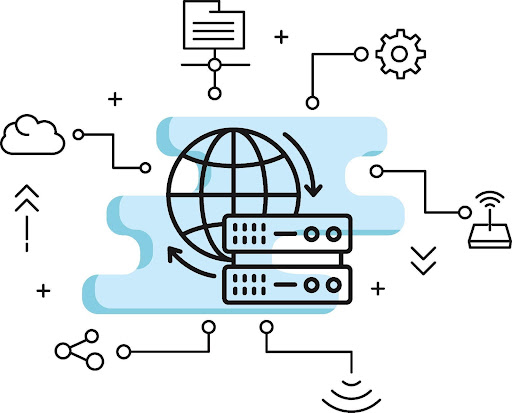
To better serve customers, proxy service providers have created solutions that improve the user experience. One such solution, which offers proxy rotation services, is a proxy rotator. Before detailing what proxy rotation and proxy rotators are, however, let’s start from the basics by explaining what a proxy server is.
What is a Proxy Server?
A proxy is any hardware or software that intercepts all web requests, assigns them a different IP address, and forwards them to a web server. This definition covers what a forward proxy is. Reverse proxies, which are integrated into a web server creating an extra layer of protection, receive the web requests on behalf of the server. These proxies are used for load balancing, prevention of Distributed Denial of Service (DDoS) attacks, and caching commonly accessed files to reduce bandwidth usage. Generally, however, the term proxy refers to forward proxies.
There are several types of proxies, which can be categorized based on the following criteria:
- Function: forward proxies, reverse proxies, HTTP proxies, and transparent proxies
- Type of IP address: residential proxies and datacenter proxies
- Assignment of IP addresses, i.e., how the addresses are assigned: static proxies and dynamic proxies
- Level of anonymity: anonymous and high anonymity proxies
- Privacy: shared proxies and dedicated/private proxies
This article will focus on two of the above criteria: the type of IP address and how the addresses are assigned.
Static and Dynamic Proxies
Static Proxies
A static proxy is an intermediary that maintains the same IP address throughout its service life. There are two main types of static proxies: static residential proxies and static datacenter proxies.
A residential proxy assigns a private IP address that is provided by an Internet Service Provider (ISP) to their customers. This, therefore, means that the customers’ devices act as intermediaries. Do note that providers of ethically sourced residential proxies have contractual agreements with these customers. Based on this background, static residential proxies do not change the assigned private IP address.
Conversely, a datacenter proxy assigns an IP address that belongs to a datacenter. This type of proxy takes two main forms, depending on the service provider. Firstly, the datacenter proxy may assign a virtual IP address generated by powerful servers located in datacenters that data and cloud storage companies own. This category is, however, prone to IP blocks because websites can easily detect that the addresses are not attached to real devices.
The second category covers datacenter proxies that assign IP addresses that are provided by ISPs. These IP addresses belong to the ISPs’ datacenters and are linked to real devices. Usually, reliable proxy providers offer this second type. As with static residential proxies, static datacenter proxies do not change the assigned IP address (check a solution from Oxylabs or any other high-quality proxies provider).
It is noteworthy, however, that static proxies have a major drawback – they have a higher propensity of getting blocked. This issue arises because they do not frequently change the identifier.
Dynamic Proxies
On the other hand, dynamic proxies provide a better buffer against blocking. This is because they change the assigned IP addresses periodically throughout the duration of service. For this reason, dynamic proxies are also known as rotating proxies, as they technically rotate the address. This proxy server achieves this feat because it offers access to an entire pool of IP addresses. It then changes the assigned identifier either randomly or after a fixed period.
Dynamic proxy servers offer better protection against IP blocking than static proxies. This makes them ideal for applications such as large-scale web scraping. In contrast, however, static proxies are used for light web data extraction, brand monitoring, anonymous browsing, visiting websites that require you to log in, and accessing geo-restricted pages and content.
Proxy Rotation
That said, you can get around the constraints of a static proxy through proxy rotation. Proxy rotation involves using a software solution known as a proxy rotator. The rotator changes otherwise static proxies on your behalf. It automatically assigns the first IP address. Next, it allows you to set the intervals between the IP changes. Once the settings are configured, the solution automatically rotates the IP addresses throughout the browsing session.
Proxy rotation is mainly used to add extra layer protection to static residential proxies and static datacenter proxies. As stated, static proxies are highly susceptible to blocking. Proxy rotators, however, prevent this by periodically changing the assigned static IP addresses based on the interval set by the user. This feature is handy in cases that ordinarily lead to IP blocking or blacklisting. Such use cases include large-scale web scraping from e-commerce sites, search engine results pages (SERPs), review sites, and more.
Conclusion
Proxy rotation refers to the use of proxy rotators to change the static IP address assigned by static residential proxies or static datacenter proxies. This practice helps prevent IP blocking. In this way, it facilitates large-scale web scraping. Simply put, proxy rotation solves the drawbacks of using static proxies.